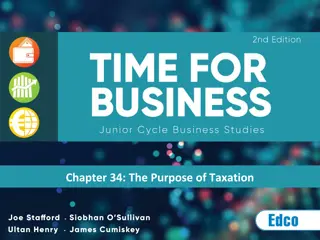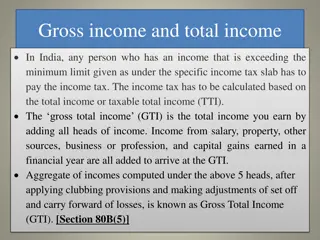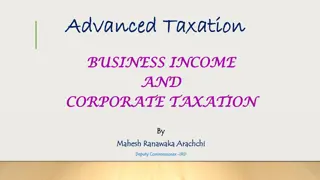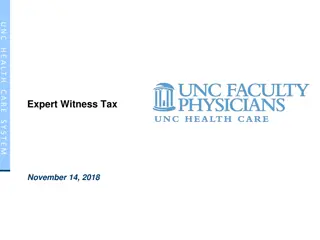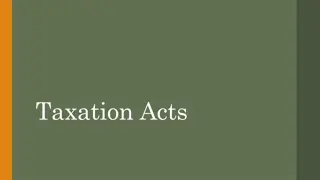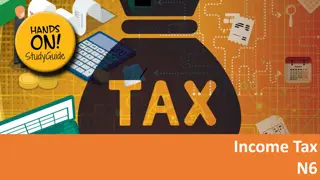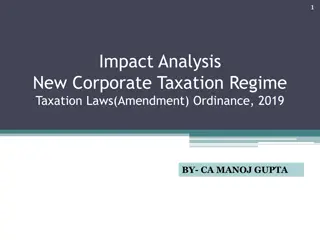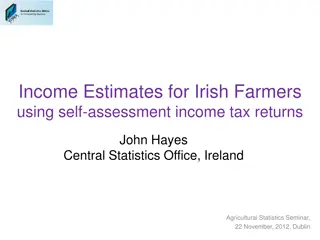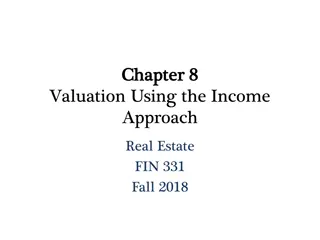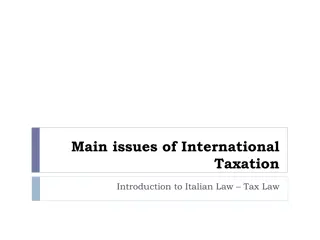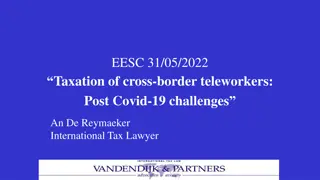Understanding Taxation in Australia: Income Declaration and Assessment
Australian taxation laws require residents to declare worldwide income while non-residents are taxed on Australian-sourced income. The tax liability calculation involves taxable income, tax offsets, other liabilities such as Medicare levy, and PAYG credits. Assessable income includes various sources like employment, super pensions, government payments, investments, and foreign income. Detailed breakdown of types of income and obligations for tax declaration are provided, emphasizing the importance of reporting accurately to comply with taxation regulations.
Download Presentation

Please find below an Image/Link to download the presentation.
The content on the website is provided AS IS for your information and personal use only. It may not be sold, licensed, or shared on other websites without obtaining consent from the author. Download presentation by click this link. If you encounter any issues during the download, it is possible that the publisher has removed the file from their server.
E N D
Presentation Transcript
INCOME YOU NEED TO DECLARE IMAGE: WESTEND61/GETTY, HARVARD BUSINESS REVIEW
TAX IN AUSTRALIA If you're anAustralian resident for tax purposes, you are taxed on your worldwide income. If you're not an Australian resident for tax purposes, you are only taxed on your Australian-sourced income. A simple formula of your tax liability is Tax on your taxable income + Tax offsets + Other liabilities PAYG credits 1) Taxable income = assessable income allowable deductions 2) Tax offsets: non-refundable tax offsets + refundable tax offsets Non-refundable offsets: Working individuals are likely to receive low-income tax offset, low- and middle- income tax offset, and beneficiary tax offset (if they receive government allowances). Seniors or retirees are likely to receive seniors and pensioners tax offset, beneficiary tax offset and Australian super income stream tax offset. For individuals involved in small business, they may be eligible for small business tax offset. Refundable tax offsets: franking credits, rebates from private health insurance, etc in calculating individual income taxes.
TAX IN AUSTRALIA 3) Other liabilities: Medicare levy + Medicare levy surcharge 4) PAYG credits: PAYGW credits + PAYGI credits PAYGW credit: With PAYG withholding, your employer withholds tax from your gross income, and you can remit the amount to the ATO when you lodge your tax return PAYGI credits: the ATO might require you to make regular payments (instalments), usually quarterly, throughout the year. When you lodge your tax return,all the amounts you've paid during the year will be offset against any tax you owe for the year. there could also be a tax withheld on bank interest if you don t provide the bank with a TFN.
ASSESSABLE INCOME The more taxable income you earn, the more tax you're supposed to pay based on the marginal tax rate. The types of assessable income you need to declare include 1. Employment income 2. Super pensions 3. Government payments and allowances 4. Investment income eg interest, rent and dividends 5. Business, partnership and trust income 6. Foreign income
1. EMPLOYMENT INCOME Employment income is money you receive from working Types of employment income you need to declare include Salary and wages (regular payment, bonuses, JobKeeper payments due to COVID-19) Allowances and other employment income (car, travel, uniforms and laundry) Lump sum payments (one-time payment, e.g. employment termination payment (ETP)) Reportable fringe benefits and super contributions You don't have to pay tax on these items, but they are used for your tax calculations and whether you are eligible to receive a range of government benefits and tax offsets.
2. SUPER PENSIONS AND ANNUITIES You must declare income you received from pensions and annuities. A pension is a series of regular payments made as a super income stream.This does not include government payments such as the age pension. An annuity is usually a series of regular payments made to you by a life insurance company instead of a lump sum payment.
3. GOVERNMENT PAYMENTS AND ALLOWANCES There are certain Australian Government payments, pensions and allowances that must be declared on your tax return. These include: the age pension carer payment Austudy Newstart JobSeeker payment Youth Allowance sickness allowance Some government payments are tax-free, but you still need to declare them in your tax return. The ATO uses this information to work out if you are eligible for any government benefits or concessions and tax offsets
4. INVESTMENT INCOME Generally, you need to declare investment income regardless of whether it's paid either: directly to you through a distribution for a partnership (such as a share club) or trust. Investment income you must declare: Interest Dividends Rental income Managed investment funds Capital gains (you should also report capital losses, if any - even though this is not deductible against regular employment income or business income, the capital loss should be recorded in the tax return and if there are any capital gains in the future, you can use the capital loss to set off against the capital gains)
5. BUSINESS INCOME If you're an individual running a business (i.e. a sole trader), you must declare the income you earn from your business on your own tax return, using a separate business schedule. You don't need to lodge a separate tax return for your business. If you re an artist, blogger, creative or maker you may need to work out if you have a hobby or business.You can use the Hobby or business tool from the ATO if you are getting money or intend to get money from creating things, such as: jewellery paintings baked goods blogs videos.
6. FOREIGN INCOME If you're anAustralian resident for tax purposes, you are taxed on your worldwide income. You must declare any foreign income in your income tax return. To avoid double taxation, a foreign income tax offset is generally available to reduce the Australian tax on the same income. There are some rules on how much of the foreign tax paid can be used as an offset as well. If you're not an Australian resident for tax purposes, you are only taxed on your Australian-sourced income.
HOW TO DECLARE YOUR INCOME At the end of this financial year, your employer will provide you with your end of year statement as either: an income statement if your employer reports to the ATO through Single Touch Payroll (STP) a payment summary (also known as a group certificate) if your employer is not yet reporting through STP, they will continue to provide you with a payment summary by 14 July What does that mean for you at tax time? If you lodge your own tax return, you can access your end of income statement through ATO online services via myGov account.
HOW TO DECLARE YOUR INCOME Most other income from health funds, banks (If they have your TFN), government agencies is pre-filled from information the ATO receives from employers and financial institutions. However, there may be some information you will need to enter manually, such as foreign income.
FURTHER QUESTIONS ATO Website: www.ato.gov.au Book an appointment with the ANU Tax Clinic submit a form at the website page https://www.rsa.anu.edu.au/rsa/anu-tax-clinic/ email us at taxclinic@anu.edu.au call us on 02 6125 4853.




